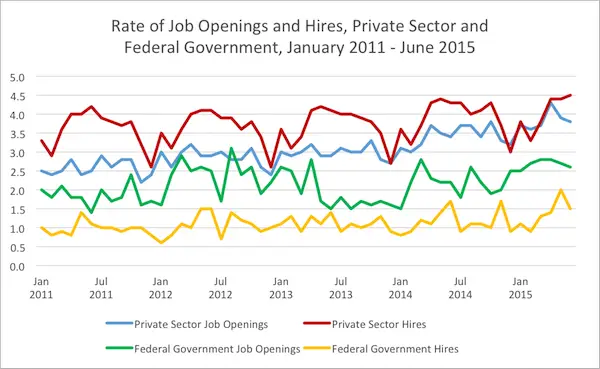The federal government hired 41,000 people in June, 14,000 fewer than in May and 4,000 fewer than in June 2014, according to new survey information obtained from the U.S. Bureau of Labor Statistics.
In 2015, the federal system has hired an average of 37,500 workers each month. In 2014, the government averaged 31,250 new hires each month. In June, total federal employment stood at 2,755,000 workers.
The government posted 73,000 job openings in June, 2,000 fewer than in May, but 11,000 more than it posted at this same time last year. The monthly average number of job openings is significantly above its recent trough in June 2013, when only 41,000 openings were posted.
In June, approximately 29,000 workers left federal service, with 11,000 quitting and the rest leaving due to retirements, layoffs, or other reasons.
The number of workers leaving the federal government declined by 10,000 compared to May, and 4,000 fewer than left the government in June 2014. The number who quit remained about the same for each year.
The monthly average number of workers hired by the federal government has slowly increased since 2011, while the number of workers leaving federal service has also increased since 2011.
Comparisons to Private Sector
The rate of new job openings, hiring, and quits, as well as the turnover rate, were all lower in the federal government when compared to the private sector in June.
The job openings rate for the private sector was 3.8 percent, compared to 2.6 percent in the federal government. The hiring rate for private sector jobs was 4.5 percent compared to 1.5 percent in government.
The turnover rate was 3.8 percent for private industry compared to 1.1 percent for federal employees, while the percentage of those quitting their jobs in the private sector was 2.2 percent, while 0.4 percent in the federal sector quit.
In the private sector, the rates for new openings, hires, turnover, and quits were all higher in June compared to the same period last year.
While the rate of new job postings in the federal government was higher compared to June 2014, the rates for hiring and turnover were slightly lower, and quit rate was the same in June 2014 and June 2015.
The U.S. Bureau of Labor Statistics collects and compiles data on job openings and labor turnover monthly from a sample of nonfarm establishments including government. For the federal government, the survey estimates the number of openings and turnover for all federal civilian jobs, including the postal service. Uniformed (military) personnel are excluded from the survey.
A job opening requires that: 1) a specific position exists and there is work available for that position, 2) work could start within 30 days whether or not the employer found a suitable candidate, and 3) the employer is actively recruiting from outside the establishment to fill the position. The hires rate is computed by dividing the number of hires by employment and multiplying that quotient by 100, while the separations rate is computed by dividing the number of separations by employment and multiplying that quotient by 100.
A more detailed discussion of concepts and methodology is available online at www.bls.gov/opub/hom/pdf/homch18.pdf.



